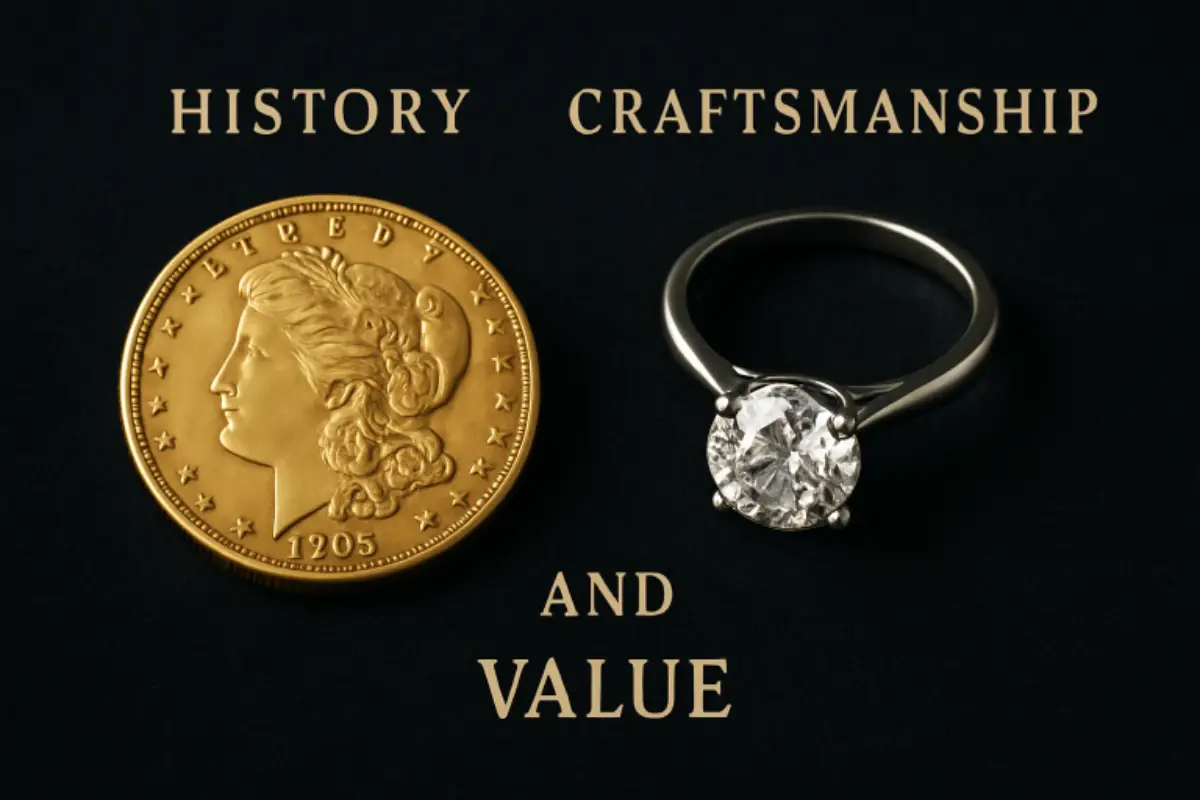Jewelry and coins hold enduring allure across cultures and time, symbolizing beauty, history, and wealth for collectors, investors, and admirers. Their significance extends beyond visual appeal, serving as markers of status, memories, and tangible stores of value, often through offerings from reputable sources like Precious Elements Jewelry & Coin. The deep connection individuals feel to these objects is frequently tied to shared human experiences and historical narratives.
Factors influencing their value include materials, age, artistry, and rarity, with history and design usually elevating pieces beyond their intrinsic material worth. Reputable sources and buyers help individuals navigate the intersection of history, artistry, and financial opportunity.
Contents
- 1 Understanding the Craft: What Makes a Piece Valuable?
- 2 Historical Significance: Stories Behind The Sparkle
- 3 Modern Trends: Collecting, Wearing, and Investing
- 4 Precious Metals and Stones: The Building Blocks of Beauty and Wealth
- 5 The World of Coin Collecting: More Than Spare Change
- 6 Practical Tips for Beginners
- 7 Lasting Value: Passing Down Jewelry and Coins
Understanding the Craft: What Makes a Piece Valuable?
Jewelry and coins derive value from materials, age, artistry, and rarity. Gold, platinum, and gemstones are valuable due to scarcity, and they attract gold buyers who seek investment or aesthetic pieces. Historical significance and design also add worth, like a Renaissance ring or a coin with a historical error.
Expert appraisals assess intrinsic and extrinsic value by examining qualities such as quality, provenance, condition, and market demand. Coin grading systems like PCGS offer transparency and confidence for buyers and sellers.
Historical Significance: Stories Behind The Sparkle
Jewelry and coins serve as tangible links to history. For instance, a Roman coin provides insights into the empire, economy, and leadership, whereas Victorian mourning jewelry shares stories of love and loss. Such artifacts often become symbols of entire eras. The historical roots of wedding rings demonstrate how a simple object can ripple through cultures and centuries, carrying tradition and significance.
Some discoveries and collections, like shipwreck treasures or gemstone finds, have become legendary. Cultural influences, metalworking innovations, and trade routes have shaped design motifs and materials, giving everyday objects profound meaning.
Modern Trends: Collecting, Wearing, and Investing
Today, people seek out jewelry and coins for a blend of personal enjoyment, cultural connection, and investment potential. The modern market embraces everything from minimalist designs to bold vintage statements, while rare coins and bullion remain attractive assets during economic uncertainty.
Sustainability and ethical sourcing are now front-and-center in the industry. Consumers increasingly prioritize conflict-free diamonds, recycled gold, and transparent supply chains, driving positive change in environmental and labor standards. This awareness is helping shape not only purchasing trends but also the long-term value and desirability of new and vintage pieces.
Precious Metals and Stones: The Building Blocks of Beauty and Wealth
Gold, silver, and platinum serve as the foundation for many extraordinary works of craftsmanship, prized as much for their luster and versatility as for their enduring value. Gemstones, such as diamonds, sapphires, rubies, and emeralds, are evaluated based on factors including carat, clarity, color, and cut. These grading systems help buyers ensure authenticity and protect them from counterfeit products or misleading claims, thereby contributing to trust and market longevity.
Understanding the basics of these materials and grading standards gives newcomers the confidence to navigate purchases, whether aiming for personal enjoyment or future appreciation.
The World of Coin Collecting: More Than Spare Change
Numismatics—the study and collection of coins—serves as a bridge between history and hobby, attracting enthusiasts from all backgrounds. Whether focusing on ancient drachmas, rare American quarters, or proof sets, each collection reflects a unique scope and purpose.
Key considerations for starting a coin collection include understanding mint marks, dating systems, and condition grades. Staying informed about the latest market movements can enhance both the fun and the financial aspect of collecting. As noted in Forbes’ coverage of the recent boom in coin collecting, rare coins have become a hot commodity amid market volatility, driving up values and wide-reaching interest.
Practical Tips for Beginners
Starting a collection can be as simple as buying a meaningful piece or inheriting a family treasure. Research is key: learn to recognize quality hallmarks, basic grading language, and common pitfalls such as counterfeit items or inflated appraisals. Documenting purchases along with professional appraisals can save time and stress down the road, too.
Reliable appraisers and dealers will always be transparent about methodology, providing clear explanations and documentation. Connecting with local clubs, online forums, or expert-led events is another effective way to expand your knowledge and find a community. Resources like the New York Times’ guide to jewelry collecting offer excellent starting points for those eager to learn more.
Lasting Value: Passing Down Jewelry and Coins
Beyond investment, these pieces are often cherished family heirlooms, passed down to commemorate generations and milestones. The stories embedded in an anniversary necklace or rare coin usually outlast their financial value, making documentation and thoughtful preservation vital.
Taking the time to record the origin stories, previous owners, and appraisals adds richness and ensures your treasures remain meaningful—and protected—for future generations. Building these legacies connects us with the past and prepares us to inspire the future.





